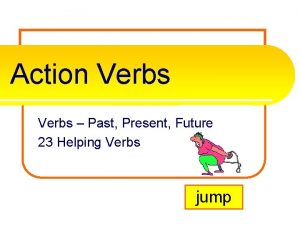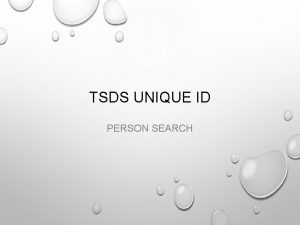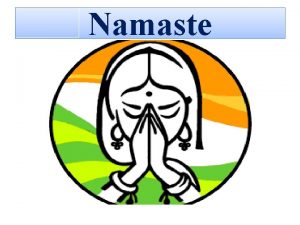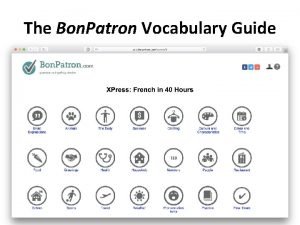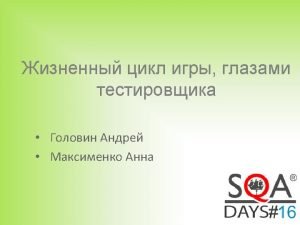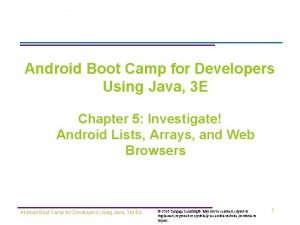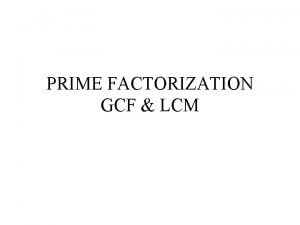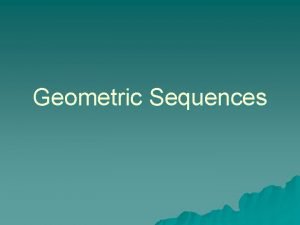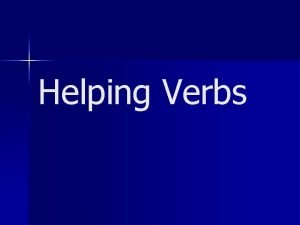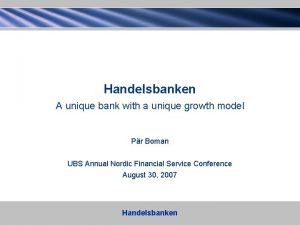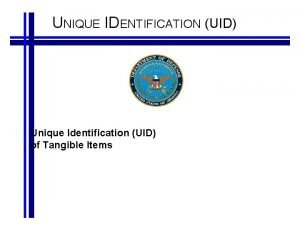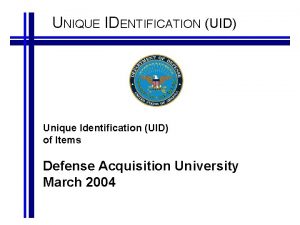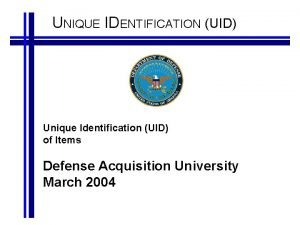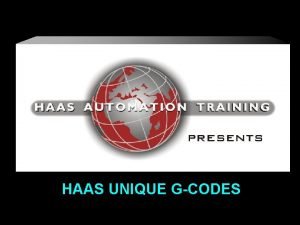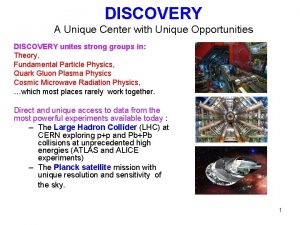Find Unique Usages Helping Developers Understand Common Usages
































- Slides: 32

Find Unique Usages Helping Developers Understand Common Usages Emad Aghayi Aaron Massey Thomas La. Toza Department of Computer Science

How should I call “initial. Capacity” method? Bob Documentation Search / Read usages of this method 2

Let’s see how to use “initial. Cap acity” by using Find Usages in Intelli. J 3

What is challenging about understanding method usages from call sites? 4

Study 1: Challenges with Find Usages Implement a feature in unfamiliar codebase 50 minutes Survey 5

Study 1: Challenges with Find Usages Key observations ❏ Developers invoke find usages and learn from usages discovered ❏ Developers have selectchallenges one or two when ❏ usages and investigate these. similar This they discover many highly would lead to participants learning usages. less from code examples. ❏ Developers find usages in tests and call sites in their codebase 6

Hypothesis Clustering similar usages might help developers understand usages more quickly and easily. 7

Find Unique Usages, Step A Input: usages Output: 4 ASTs of usages AST Usage 3 AST Usage 4

Find Unique Usages, Step B Input: Asts, Gum. Tree algo Output: Diffs of Asts AST Usage 3 Diff ast. Diffs = gumtree. Ast. Comparator (AST 3, AST 4); Set similiarities = ast. Diffs. get. Mappings. Comp(); AST Usage 4

Find Unique Usages, Step C Input: Similarity and diffs Output: Score = 2 X similar_nodes / (2 X similar_nodes + AST 3_differ + AST 4_differ) Similarity scores are calculated for all pairs of usages.

Find Unique Usages, Step D Input: Similarity scores Output: groups

Find Usages Vs. Find Unique 12

Study 2: Evaluation Implement a feature in unfamiliar codebase Find Unique Usages Implement a feature in unfamiliar codebase 50 min Interview 13

Study 2: Key Results Find Unique Usage group completed task in 21 minutes Control group completed task in 33 minutes Interacting with usages ❏ Read usages sequentially. Began from the first result and proceeded further. ❏ Did not real all usages. Selected the best usage that might help them. 14

Study 2: Key Results More successful participants ❏ Used Find Usages with the Find In Path tools ❏ Expanded and skimmed all usages. Selected the best usage that might help them Challenges in making recursive use of Find Usages ❏ Lost their place in the call graph and became disoriented ❏ Spent time remembering where they were when re-invoking the first command they began with 15

Discussion and Future Work Offering additional evidence for the value of call graph navigation tools How would developers' behavior change if the IDE did not highlight this first usage? 16

Discussion and Future Work Systematically investigate the impact of the number of clusters chosen There a wide range of clustering techniques that might be used to cluster usage sites. For example, hierarchical clustering 17

Acknowledgement Jon Bell This work was supported in part by the National Science Foundation under grants CCF-1414197 and CCF-1845508. 18

Questions 19

Find Unique Usages Helping Developers Understand Common Usages Emad Aghayi Aaron Massey Thomas La. Toza Department of Computer Science

Exploratory Study, Find Usages, and its results ● We found participants had difficulty parsing through the many results ● Users would typically select only one or two results and focus on those ● A valuable example would frequently not be the first or second result. 21

Primer on Code Clones ● Ongoing field of research that is typically focused on detection of redundancy. ● Makes frequent use of string, AST, or other distancing metrics to identify two pieces of code as clones or duplicates/redundant of each other. ● Useful for refactoring blocks of redundant code with a single function call ● Generally, code clones are bad - duplicate clones. 22

Back to Find Unique Usages ● We heavily borrow from code clones work ○ ○ We say that two examples have similar context if they are essentially weak code clones. By weak code clones, we mean there is similarity, but not enough to necessarily be redundant. ● We group our weak code clones as a method of grouping examples ○ ○ Different groups are meant to represent different use-cases. E. g. tests verifying a particular piece of functionality would be one group. ● To us, code clones are good, or at least neutral. ○ ○ More weak code clones mean more grouping of examples. But this is tricky because we have to balance threshold of what is in the same group. 23

Problem Statement: Learning how to use an artifact in a codebase : Documentation ❏ Hard to maintain it update, Might not exist, Less reliable in closed-source code Option 2: Manually parsing code ❏ Slow, Difficult and easy to get wrong Option 3: Learning by example ❏ ❏ Easier than manually parsing code Knowledge is tightly coupled with code and easier to maintain Varied examples offer information on different use-cases Tooling support exists, like “Find Usages”, “Open call hierarchy” and “Grep” 24

Why searching in codebase is important? ❏ Understanding existing code is one of developers most time-consuming activities ❏ Developers generally avoid relying on documentation Instead, developers tend to rely primarily on the code itself ❏ The most frequent developer activity is code search ❏ 94% of developers search when they are working on maintenance tasks 25

Search for usage tools Find Usages Open call hierarchy 26

Study 2: Key Results ❏ Usages was easier to read when they contained literals directly in the call site rather than referencing variables or expressions defined elsewhere. ❏ In both conditions, four participants struggled with method overload. 27

Find Unique Usages Helping Developers Understand Common Usages Department of Computer Science, George Mason University Emad Aghayi Aaron Massey Thomas La. Toza

Find Unique Usages Helping Developers Understand Common Usages Department of Computer Science, George Mason University Emad Aghayi Aaron Massey Thomas La. Toza

Study 2: Evaluation ● 12 participants (4 software engineers + 5 grad students + 3 undergrad students) ● Between subjects study comparing against developers with Intelli. J Find Usages ● Flying. Saucer project, approx. 99 KLOC ● Semi-structured interview with participants 30

Discussion and Future Work ● Why developers choose to focus on first usages? ! By default, both Find Unique Usages and Find Usages in Intelli. J expand highlight the first usage in the list. ○ It is unclear how developers' behavior might change if the IDE did not highlight this first usage. ● Using more sophisticated clustering techniques like hierarchical clustering 31

Introducing Find Unique Usages Input: Asts, Gum. Tree Input: usages Output: 4 ASTs of usages algo Output: Diffs of Asts Input: Diffs, equation Output: scores Input: usages, scores, max of Min algo Output: clusters we adapted an approach from prior work for computing similarity Example: AST created from Usage 3 Max of Min alog: 1. It first finds the Shared is the number of shared nodes between two minimum trees calculated by Gum. Tree, AST 1 is the number between of nodes which differ in usagesimilarity 1 and AST 2 is the usage and all number of nodes which differ in usage 2. members ofofall Similarity scores are calculated for all pairs usages. clusters separately and memoizes them. 1. It choose the max of these minimums and assign the usage to that cluster 32
 Is would a helping verb
Is would a helping verb To understand recursion you must understand recursion
To understand recursion you must understand recursion Gilded age westward expansion
Gilded age westward expansion Who is this person image search
Who is this person image search Matrika hospital rewari
Matrika hospital rewari Moodle development
Moodle development Erp for real estate developers
Erp for real estate developers Krowemo meaning
Krowemo meaning Sticky notes developers
Sticky notes developers Inutamago
Inutamago Lebonpatron
Lebonpatron Reactive extensions net core
Reactive extensions net core Facbook
Facbook Developers google speed
Developers google speed Motivating software engineers
Motivating software engineers Manitoba prospectors and developers association
Manitoba prospectors and developers association Game developers
Game developers Google forms developers
Google forms developers Aesthetics developers
Aesthetics developers Builders and property developers module in tally.erp 9
Builders and property developers module in tally.erp 9 Developers android com
Developers android com Android boot camp for developers using java
Android boot camp for developers using java Android boot camp for developers using java
Android boot camp for developers using java What is the greatest common factor of 48 and 60?
What is the greatest common factor of 48 and 60? Common anode and common cathode
Common anode and common cathode Factor tree of 56
Factor tree of 56 Lowest common factor
Lowest common factor Lcm of 6 and 12
Lcm of 6 and 12 Multiples of 9 and 21
Multiples of 9 and 21 Greatest common factor of 60
Greatest common factor of 60 Factor tree of 225
Factor tree of 225 How to find least common multiple
How to find least common multiple Geometric sequence ex
Geometric sequence ex
